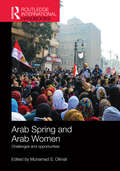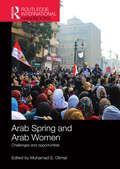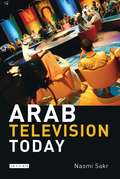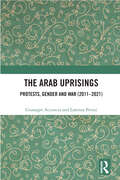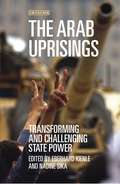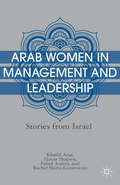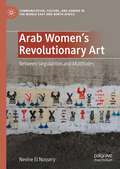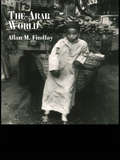- Table View
- List View
The Arab Spring: Will It Lead to Democratic Transitions? (Asan-Palgrave Macmillan Series)
by Clement Henry Ji-Hyang JangThis timely project on the Arab Spring was initiated to provide The Asan Institute's own assessment of the changes currently taking place in the region and their significant implications for South Korea.
Arab Spring and Arab Women
by Muhamad OlimatThis volume examines the role of Arab women in Arab Spring and their contribution to the ongoing process of change sweeping the region. The book begins with an examination of the process of democratization and its impediments in the Arab World since the Second World War. It then looks at the conditions that led to the upsurge of the so-called Arab Spring. Finally, it underscores women’s role as participants, organizers, leaders, but also as victims. The main thesis of the book is that while Arab women were an integral part of the revolutionary efforts within the Arab Spring paradigm, they did not benefit from their sacrifices. Although they continue to be part of the process of change, their gains, rights and scope for participation are still limited. If the expansion of women’s participation and the scope of their rights do not seem to be a priority for revolutionary forces, women have made remarkable achievements, especially in some Arab Spring countries such as Yemen and Libya. The book includes case studies of some Arab Spring countries and other countries influenced by developments: Egypt, Bahrain, Kuwait, Libya, Yemen, Algeria, Jordan, Morocco and Saudi Arabia. It calls on revolutionary and reformist forces to give special attention to issues related to Arab women, as they are an indispensable pillar in the process of reform, development, peace and stability in the Middle East.
Arab Spring and Arab Women
by Muhamad S. OlimatThis volume examines the role of Arab women in Arab Spring and their contribution to the ongoing process of change sweeping the region. The book begins with an examination of the process of democratization and its impediments in the Arab World since the Second World War. It then looks at the conditions that led to the upsurge of the so-called Arab Spring. Finally, it underscores women’s role as participants, organizers, leaders, but also as victims. The main thesis of the book is that while Arab women were an integral part of the revolutionary efforts within the Arab Spring paradigm, they did not benefit from their sacrifices. Although they continue to be part of the process of change, their gains, rights and scope for participation are still limited. If the expansion of women’s participation and the scope of their rights do not seem to be a priority for revolutionary forces, women have made remarkable achievements, especially in some Arab Spring countries such as Yemen and Libya. The book includes case studies of some Arab Spring countries and other countries influenced by developments: Egypt, Bahrain, Kuwait, Libya, Yemen, Algeria, Jordan, Morocco and Saudi Arabia. It calls on revolutionary and reformist forces to give special attention to issues related to Arab women, as they are an indispensable pillar in the process of reform, development, peace and stability in the Middle East.
The Arab State (Routledge Library Editions: Politics of the Middle East)
by Giacomo LucianiIt has often been argued that Arab states are arbitrary political creations, lacking historical or present legitimacy. This book, first published in 1990, provides a different picture of ‘the Arab state’, drawing on historical, economic, philosophical and sociological perspectives to give a balanced and convincing view of the complex reality of contemporary Arab politics. The contributors, from the Arab countries, from Europe and the United States, investigate the roots of the nation state in the Arab world, evaluating in particular the economic bases of individual states. They discuss the evolution of Arab societies and the way this is reflected in different states, and examine the problems of domestic and international integration in the Arab context. Original and comprehensive in its findings, this is an essential text on the fundamental political structure of the Arab world. Its interdisciplinary breadth makes possible an entirely new reading of the political reality of the Middle East.
The Arab State (Routledge Library Editions: Politics of the Middle East)
by Giacomo LucianiIt has often been argued that Arab states are arbitrary political creations, lacking historical or present legitimacy. This book, first published in 1990, provides a different picture of ‘the Arab state’, drawing on historical, economic, philosophical and sociological perspectives to give a balanced and convincing view of the complex reality of contemporary Arab politics. The contributors, from the Arab countries, from Europe and the United States, investigate the roots of the nation state in the Arab world, evaluating in particular the economic bases of individual states. They discuss the evolution of Arab societies and the way this is reflected in different states, and examine the problems of domestic and international integration in the Arab context. Original and comprehensive in its findings, this is an essential text on the fundamental political structure of the Arab world. Its interdisciplinary breadth makes possible an entirely new reading of the political reality of the Middle East.
Arab Subcultures: Transformations in Theory and Practice (Library of Modern Middle East Studies)
by Tarik Sabry Layal FtouniWhat is 'Arab' about Arab subcultures? This is the first book to set out to delineate different ways of studying and theorising Arab subcultural groups and practices, including film, graffiti, music, live art performances, Arab techies and youth cultures. Contributors tackle a number of questions including: How is the study of Arab subcultures to be theorised? How are we to analyse such creative processes in a new worldliness characterised by trans-temporality and trans-subjectivity?
Arab Television Today
by Naomi SakrThere is a great deal at stake for everyone in the future of Arab television. Political and social upheavals in this central but unsettled region are increasingly played out on television screens and in the tussles over programming that take place behind them. "Al-Jazeera" is of course only one player among a still-growing throng of satellite channels, which now include private terrestrial stations in some Arab states. It is an industry urgently needing to be made sense of; this book does exactly this in a very readable and authoritative way, through exploring and explaining the evolving structures and content choices in both entertainment and news of contemporary Arab television. It shows how owners, investors, journalists, presenters, production companies, advertisers, regulators and media freedom advocates influence each other in a geolinguistic marketplace that encompasses the Arab region itself and communities abroad.Probing internal and external interventions in the Arab television landscape, the book offers a timely and compelling sequel to Naomi Sakr's "Satellite Realms: Transnational Television, Globalization and the Middle East", which won the Middle Eastern Studies Book Prize in 2003.
Arab Television Today
by Naomi SakrThere is a great deal at stake for everyone in the future of Arab television. Political and social upheavals in this central but unsettled region are increasingly played out on television screens and in the tussles over programming that take place behind them. Al-Jazeera is of course only one player among a still-growing throng of satellite channels, which now include private terrestrial stations in some Arab states. It is an industry urgently needing to be made sense of; this book does exactly this in a very readable and authoritative way, through exploring and explaining the evolving structures and content choices in both entertainment and news of contemporary Arab television. It shows how owners, investors, journalists, presenters, production companies, advertisers, regulators and media freedom advocates influence each other in a geolinguistic marketplace that encompasses the Arab region itself and communities abroad. Probing internal and external interventions in the Arab television landscape, the book offers a timely and compelling sequel to Naomi Sakr's 'Satellite Realms: Transnational Television, Globalization and the Middle East', which won the Middle Eastern Studies Book Prize in 2003.
The Arab Uprisings: Protests, Gender and War (2011-2021)
by Giuseppe Acconcia Lorenza PeriniThis book investigates the role of social groups in mobilizing resources for protests in repressive contexts. In particular, it examines the impact of organizations and informal groups on individual engagement in the protests developed in 2010–2011 in Tunisia, Egypt, and Syria. Empirical analysis draws on a wave of events and protests that took place between 2010 and 2021. It explores how, in repressive contexts, spontaneous groups and more established and formal organizations continuously switch from one form to another, transforming themselves faster than they would do in democratic contexts.
The Arab Uprisings: Protests, Gender and War (2011-2021)
by Giuseppe Acconcia Lorenza PeriniThis book investigates the role of social groups in mobilizing resources for protests in repressive contexts. In particular, it examines the impact of organizations and informal groups on individual engagement in the protests developed in 2010–2011 in Tunisia, Egypt, and Syria. Empirical analysis draws on a wave of events and protests that took place between 2010 and 2021. It explores how, in repressive contexts, spontaneous groups and more established and formal organizations continuously switch from one form to another, transforming themselves faster than they would do in democratic contexts.
The Arab Uprisings: Transforming and Challenging State Power (Library of Modern Middle East Studies)
by Nadine Sika Eberhard KienleThe uprisings which spread across the Middle East and North Africa in late 2010 and 2011 irrevocably altered the way in which the region is now perceived. But in spite of the numerous similarities in these protests, from Tunisia and Egypt to Yemen and Bahrain, their broader political effects display important differences. This book analyses these popular uprisings, as well as other forms of protest, and the impact they had on each state. Why were Mubarak and Bin Ali ousted relatively peacefully in Egypt and Tunisia, while Qadafi in Libya and Saleh in Yemen fought violent battles against their opponents? Why do political transformations differ in countries that were able to shed their autocratic presidents? And why have other regimes, including Morocco and Saudi Arabia, experienced only limited protests or managed to repress and circumvent them? Looking at the aftermath and transitional processes across the region, this book is a vital retrospective examination of the uprisings and how they can be understood in the light of state formation and governmental dynamics.
The Arab Uprisings and Malaysia’s Islamist Movements: Influence, Impact and Lessons (Routledge Contemporary Southeast Asia Series)
by Mohd Irwan SaidinThis book examines the attitude of Malaysia’s Islamist movements – The Pan-Malaysian Islamic Party (PAS); The National Trust Party (AMANAH); The Muslim Youth Movement of Malaysia (ABIM) and the Malaysian Muslim Solidarity Front (ISMA) – towards the Arab Uprisings in the Middle East and North Africa. The book analyses the perceptions of Islamist movement activists, politicians and members in Malaysia towards the 2011 Arab Uprisings, popularly known as the ‘Arab Spring’. A questionnaire based-survey as well as in-depth interviews with activists and leaders ranging from individuals in opposing political parties (PAS and AMANAH) to non-government Islamist organisations (ABIM and ISMA) informs the findings of the book. Using quantitative and qualitative methods, the author analyses how the events impacted the activism, political approach and attitudes of the members of Islamic movements towards the issues of regime change, civil disobedience, political revolution, democracy, Islamism and political stability. The book demonstrates that Malaysian Islamists are mainly in support of free and democratic elections as a medium for political change as opposed to overthrowing the previous BN-led regime via civil disobedience, street demonstration or ‘revolution’. A novel approach in examining the connections between Islamic movements in Southeast Asia and the Middle East and Africa, this book will be of interest to academics in the fields of Politics, History, Social Movements, Political Islam, Middle Eastern Studies and Southeast Asian Studies.
The Arab Uprisings and Malaysia’s Islamist Movements: Influence, Impact and Lessons (Routledge Contemporary Southeast Asia Series)
by Mohd Irwan SaidinThis book examines the attitude of Malaysia’s Islamist movements – The Pan-Malaysian Islamic Party (PAS); The National Trust Party (AMANAH); The Muslim Youth Movement of Malaysia (ABIM) and the Malaysian Muslim Solidarity Front (ISMA) – towards the Arab Uprisings in the Middle East and North Africa. The book analyses the perceptions of Islamist movement activists, politicians and members in Malaysia towards the 2011 Arab Uprisings, popularly known as the ‘Arab Spring’. A questionnaire based-survey as well as in-depth interviews with activists and leaders ranging from individuals in opposing political parties (PAS and AMANAH) to non-government Islamist organisations (ABIM and ISMA) informs the findings of the book. Using quantitative and qualitative methods, the author analyses how the events impacted the activism, political approach and attitudes of the members of Islamic movements towards the issues of regime change, civil disobedience, political revolution, democracy, Islamism and political stability. The book demonstrates that Malaysian Islamists are mainly in support of free and democratic elections as a medium for political change as opposed to overthrowing the previous BN-led regime via civil disobedience, street demonstration or ‘revolution’. A novel approach in examining the connections between Islamic movements in Southeast Asia and the Middle East and Africa, this book will be of interest to academics in the fields of Politics, History, Social Movements, Political Islam, Middle Eastern Studies and Southeast Asian Studies.
Arab Voices: The human rights debate in the Middle East (Routledge Library Editions: Society of the Middle East)
by Kevin DwyerThis book, first published in 1991, moves beyond sensational headlines to explore how Middle Eastern men and women speak and feel about the societies in which they live. Kevin Dwyer makes use of extensive research and interview material from Egypt, Tunisia and Morocco and combines first-hand testimony with vivid and illuminating analysis. The voices are those of lawyers, political militants, religious thinkers, journalists and human rights activists who focus their discussion on the question of human rights and critical issues in social and cultural life.
Arab Voices: The human rights debate in the Middle East (Routledge Library Editions: Society of the Middle East)
by Kevin DwyerThis book, first published in 1991, moves beyond sensational headlines to explore how Middle Eastern men and women speak and feel about the societies in which they live. Kevin Dwyer makes use of extensive research and interview material from Egypt, Tunisia and Morocco and combines first-hand testimony with vivid and illuminating analysis. The voices are those of lawyers, political militants, religious thinkers, journalists and human rights activists who focus their discussion on the question of human rights and critical issues in social and cultural life.
The Arab Winter: A Tragedy
by Noah FeldmanWhy the conventional wisdom about the Arab Spring is wrongThe Arab Spring promised to end dictatorship and bring self-government to people across the Middle East. Yet everywhere except Tunisia it led to either renewed dictatorship, civil war, extremist terror, or all three. In The Arab Winter, Noah Feldman argues that the Arab Spring was nevertheless not an unmitigated failure, much less an inevitable one. Rather, it was a noble, tragic series of events in which, for the first time in recent Middle Eastern history, Arabic-speaking peoples took free, collective political action as they sought to achieve self-determination.Focusing on the Egyptian revolution and counterrevolution, the Syrian civil war, the rise and fall of ISIS in Syria and Iraq, and the Tunisian struggle toward Islamic constitutionalism, Feldman provides an original account of the political consequences of the Arab Spring, including the reaffirmation of pan-Arab identity, the devastation of Arab nationalisms, and the death of political Islam with the collapse of ISIS. He also challenges commentators who say that the Arab Spring was never truly transformative, that Arab popular self-determination was a mirage, and even that Arabs or Muslims are less capable of democracy than other peoples.Above all, The Arab Winter shows that we must not let the tragic outcome of the Arab Spring disguise its inherent human worth. People whose political lives had been determined from the outside tried, and for a time succeeded, in making politics for themselves. That this did not result in constitutional democracy or a better life for most of those affected doesn't mean the effort didn't matter. To the contrary, it matters for history—and it matters for the future.
Arab Women and the Media in Changing Landscapes
by Elena Maestri Annemarie ProfanterThis volume explores the dialogue between Arab media and global developments in the information age, looking at the influence of new technologies in Arab societies and the evolving role of Arab women in 'old' and 'new' media. By gathering together contributions from both Arab and non-Arab scholars alike, a timely and important collection is presented that sheds new light on the growing involvement, role and image of Arab women in the media.
Arab Women and the Media in Changing Landscapes (PDF)
by Elena Maestri Annemarie Profanter Lubna Al-KaziThis volume explores the dialogue between Arab media and global developments in the information age, looking at the influence of new technologies in Arab societies and the evolving role of Arab women in ‘old’ and ‘new’ media. By gathering together contributions from both Arab and non-Arab scholars alike, a timely and important collection is presented that sheds new light on the growing involvement, role and image of Arab women in the media.
Arab Women in Management and Leadership: Stories from Israel
by K. Arar T. Shapira F. Azaiza R. Hertz-LazarowitzAn exploration of the life-stories of 22 pioneer Arab women who have forged their path to management and leadership in education and welfare, overcoming challenges imposed by a patriarchal society that sees female leadership as a threat.
Arab Women in the Middle Ages: Private Lives and Public Roles
by Shirley GuthrieRegardless of social rank and religion, whether Christian, Jew, or Muslim, Arab women in the middle ages played an important role in the functioning of society. This book is a journey into their daily lives, their private spaces and public roles. First we are introduced into the women's sanctuaries, their homes, and what occurs within its realm - marriage and contraception, childbirth and childcare, culinary traditions, body and beauty rituals - providing rare insight into the rites and rituals prevalent among the different communities of the time. These women were also much present in the public arena and made important contributions in the fields of scholarship and the affairs of state. A number of them were benefactresses, poets, calligraphers, teachers and sales women. Others were singing girls, professional mourners, bath-attendants and prostitutes. How these women managed their daily affairs, both personal and professional, defined their roles in the wider spheres of society. Drawing from the Islamic traditions, as well as legal documents, historical sources and popular chronicles of the time, Guthrie's book offers an informative study of an area which remaisn relatively unexplored. 'A useful survey on Arab (mostly Muslim) women's lives in past centuries.' RJAS 'Of greatest use to educators and lecturers looking for diverse and entertaining details of various aspects of medieval Near Eastern social life.' International Journal of Middle Eastern Studies 'Reveals a broad understanding of the subject' MESA Bulletin
Arab Women's Revolutionary Art: Between Singularities and Multitudes (Communication, Culture, and Gender in the Middle East and North Africa)
by Nevine El NosseryThis book examines the ways in which women in the contemporary Middle East and North Africa have re-imagined revolutionary discourses through creativity and collective action as a means of resistance. Encompassing a stunning array of forms and genres, such as graffiti, street performance, photography, phototexts, novels, and comics, the book draws from a vast spectrum of artistic production in revolutionary periods between 2011 and 2022 in Egypt, Tunisia, Morocco, and Algeria. El Nossery sheds light on women’s postrevolutionary artistic output by engaging an interdisciplinary approach: the book is divided into three sections which foreground the unique relationship between textual, visual, and performative modes as they intertwine with art and politics. Arab Women’s Revolutionary Art thereby aims to demonstrate how art, as always oriented towards an open future, can preserve the revolutionary spirit that was sparked in 2011 by documenting what happened and determining which stories would be told. The revolution, therefore, continues.
The Arab World (Routledge Introductions to Development)
by Allan M. FindlayDisruption following the Gulf War, and the need to satisfy both rising economic aspirations and the Islamic values of the region's peoples, demands fresh examination of development issues in the Arab world. This introductory text assesses how agricultural, industrial and urban development has evolved in the Arab region. Contrasting Arab and Western interpretations of `development', it draws on case studies covering states as diverse as Saudi Arabia, Yemen, Morocco and Jordan. The author suggests that until the Arabs define their own identity, there will continue to be `change' but not necessarily `progress' in the region.
The Arab World (Routledge Introductions to Development)
by Allan M. FindlayDisruption following the Gulf War, and the need to satisfy both rising economic aspirations and the Islamic values of the region's peoples, demands fresh examination of development issues in the Arab world. This introductory text assesses how agricultural, industrial and urban development has evolved in the Arab region. Contrasting Arab and Western interpretations of `development', it draws on case studies covering states as diverse as Saudi Arabia, Yemen, Morocco and Jordan. The author suggests that until the Arabs define their own identity, there will continue to be `change' but not necessarily `progress' in the region.
Arabia & The Gulf
by Andrew WheatcroftFirst published in 1982. The art of photography is now an immensely popular hobby throughout the world. However, when it first started it was available only to a very few people who had the money and determination to indulge in this activity. Then as now, each photograph is a reflection of the interests and tastes of the photographer, be he amateur or professional. The present book is not just a collection o f photographs but rather an illustrated historical record. In other words it is a chronicle which is brought dramatically to life by the photographs. As its title indicates the book deals with a region about which very little was known in the West during the nineteenth and early twentieth century. It covers the region not only geographically but also sociologically and over a fairly long period of time. It spans the region from the heart of Arabia, through Western Arabia (Jeddah, Mecca and Medina), Yemen, Oman and the Gulf. It depicts the life of the Arab, not only rulers but also the ordinary people in their daily activities. These photographs also show the changes which have taken place over the period from 1880 to 1950, giving the reader an opportunity to link the past with the present.
Arabia & The Gulf
by Andrew WheatcroftFirst published in 1982. The art of photography is now an immensely popular hobby throughout the world. However, when it first started it was available only to a very few people who had the money and determination to indulge in this activity. Then as now, each photograph is a reflection of the interests and tastes of the photographer, be he amateur or professional. The present book is not just a collection o f photographs but rather an illustrated historical record. In other words it is a chronicle which is brought dramatically to life by the photographs. As its title indicates the book deals with a region about which very little was known in the West during the nineteenth and early twentieth century. It covers the region not only geographically but also sociologically and over a fairly long period of time. It spans the region from the heart of Arabia, through Western Arabia (Jeddah, Mecca and Medina), Yemen, Oman and the Gulf. It depicts the life of the Arab, not only rulers but also the ordinary people in their daily activities. These photographs also show the changes which have taken place over the period from 1880 to 1950, giving the reader an opportunity to link the past with the present.

